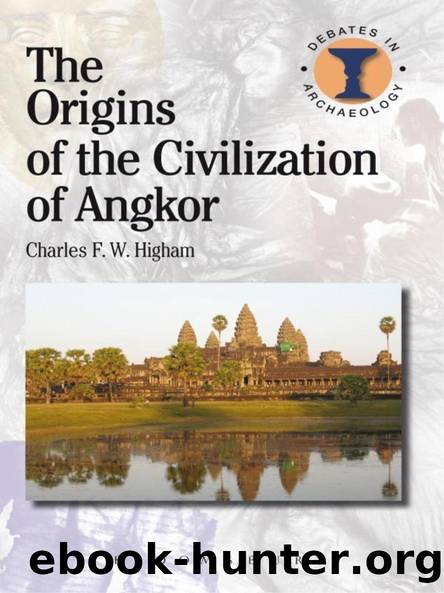The Origins of the Civilization of Angkor by Charles Higham Richard Hodges

Author:Charles Higham, Richard Hodges [Charles Higham, Richard Hodges]
Language: eng
Format: epub
ISBN: 9781472584083
Barnesnoble:
Publisher: Bloomsbury Academic
Published: 2014-10-23T00:00:00+00:00
A model for social change
The outburst of social display at Ban Non Wat during the early Bronze Age requires a reconsideration of the social impact of metallurgy in Southeast Asia. In doing so, I turn to the political model as described by Hayden (2001a, b, 2009), a model that involves the behaviour of aggrandizer individuals in transegalitarian societies (Clark and Blake 1996). An essential element in such societies is competitive emulation for status, involving differential access to resources and social distinctions based on prestige and wealth. A transegalitarian society may thus be defined as one in which social inequalities are defined and expressed by the private ownership of rare prestige goods, and the accumulation of valuables that can be employed through such a medium as feasting to distinguish the relative wealth and status of different corporate groups within society. Social inequalities, while compatible with some heterarchic features, can be perceived archaeologically through the presence of distinctively large houses, the construction of ritual monuments or facilities and the demonstration of wealth through mortuary indicators, particularly when adults and young are restricted to a specific burial area. Success for a particular lineage within the community turns among other factors, on charismatic leadership, wealth creation, the display of valuables in life and the provision of debt obligations at death by the giving of opulent feasts (Owens and Hayden 1997, Dietler and Hayden 2001).
Clark and Blake (1996) have emphasized the role of aggrandizers in generating social distinctions through their pursuit of prestige and esteem. Their model of transegalitarian social change, formulated in the context of the archaeological record in the Mazatan region of coastal Mexico, incorporates ideas that are directly relevant to the present discussion. It begins with the notion that human societies include aggrandizers, those who seek renown and prestige. How can this be achieved within a single generation, and by what means might it be transferred through succeeding generations? It is certainly advantageous to live in a community that has unfettered access to others of similar standing, in a physical environment where exchange routes employing passes or river routes favour access to prestige valuables. In this respect, the inhabitants of Ban Non Wat could take advantage of the Mun River as a conduit for goods from remote sources. The flat river floodplain is well suited to rice cultivation and there is an abundant supply of salt, still used to preserve wet season fish for dry season consumption. There is then, ample opportunity for aggrandizers to accumulate valuables for competitive display and emulation. Already during the Neolithic, marine shell was being obtained through exchange.
With the Bronze Age, marble, copper and tin were added to the list of valuables that could be used to display social prominence. And this brings one to the core of the issue. As Clark and Blake have written, âThe conversion of external resources into social leverage locally requires (near) exclusive access to outside goods, material or informationâ (Clark and Blake 1996: 19). When this monopolizing of desirables is maintained, then high esteem and rank can be passed down the generations.
Download
This site does not store any files on its server. We only index and link to content provided by other sites. Please contact the content providers to delete copyright contents if any and email us, we'll remove relevant links or contents immediately.
The Sympathizer by Viet Thanh Nguyen(4305)
The Rape of Nanking by Iris Chang(4136)
World without end by Ken Follett(3427)
Ants Among Elephants by Sujatha Gidla(3417)
Blood and Sand by Alex Von Tunzelmann(3138)
Japanese Design by Patricia J. Graham(3109)
City of Djinns: a year in Delhi by William Dalrymple(2514)
The Queen of Nothing by Holly Black(2491)
Foreign Devils on the Silk Road: The Search for the Lost Treasures of Central Asia by Peter Hopkirk(2433)
India's Ancient Past by R.S. Sharma(2414)
Inglorious Empire by Shashi Tharoor(2394)
Tokyo by Rob Goss(2388)
In Order to Live: A North Korean Girl's Journey to Freedom by Yeonmi Park(2344)
India's biggest cover-up by Dhar Anuj(2318)
Tokyo Geek's Guide: Manga, Anime, Gaming, Cosplay, Toys, Idols & More - The Ultimate Guide to Japan's Otaku Culture by Simone Gianni(2314)
The Great Game: On Secret Service in High Asia by Peter Hopkirk(2305)
Goodbye Madame Butterfly(2202)
Batik by Rudolf Smend(2123)
Living Silence in Burma by Christina Fink(2037)
